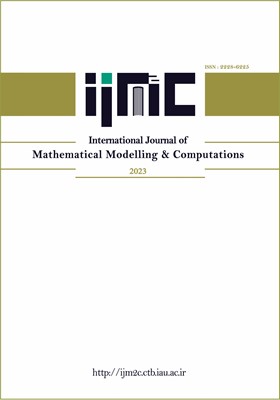Analytical Solution of the Effect of Awareness Program by Media on the Spread of an Infectious Disease by Homotopy Perturbation Method
Subject Areas : International Journal of Mathematical Modelling & Computations
1 - Department of Mathematics,
Sri Krishna Adithya College of Arts and Science
Keywords: numerical simulation, Homotopy Perturbation method, Approximate Solution, Nonlinear system of Differential Equation,
Abstract :
In this paper, the nonlinear dynamical system modeling the effect of awareness program by media on spread of infectious disease is considered. The model is mathematically formulated by the deterministic compartmental model consisting of susceptible population, infected population, aware population and cumulative density of awareness spread by the media. Homotopy perturbation method is used to obtain the approximate solution of the governing nonlinear differential equation, which consists in determining the series solution convergent to the exact solution or enabling to built the approximate solution of the problem. Numerical solutions are obtained and the results are discussed graphically using Maple. The method allows to determine the solution in form of the continuous function, and shows the significance of awareness program driven by media in spread of an infectious disease, but due to immigration, the disease may remain endemic . The simulation analysis of the model with different parameter values confirms the analytical results.
[1] S. Abubakar, N. I. Akinwande, O. R. Jimoh, F. A. Oguntolu and O. D. Oguwumu, Approximate
solution of SIR infectious disease model using homotopy perturbation method, Pacific Journal of
Science and Technology, 14 (2) (2013) 163–169.
[2] G. Adamu, M. Bawa, M. Jiya and U. D. Chado, A mathematical model for the dynamics of Zika virus
via homotopy perturbation method, Journal of Applied Science and Environmental Management,
21 (4) (2017) 615–623.
[3] F. A. Adesuyi, A. Karawak and O. D. Adeyemi and F. R. Adunola, A mathematical model for
capturing Cholera spread and containment options, International Journal of Mathematical Sciences
and Computing, 4 (2018) 15–40.
[4] G. Devipriya, Analytical solution of dengue model with maturation delay by homotopy perturbation
method, Asia Mathematika, 1 (2017) 49–60.
[5] B. Ebenezer, A. Khan, M. A. Khan and S. Islam, Solution of the Ebola epidemic model by homotopy
perturbation method, Journal of Applied Environmental and Biological Sciences, 6 (2016) 41–49.
[6] S. Edward and N. Nyerere, A mathematical model for the dynamics of cholera with control measures,
Applied and Computational Mathematics, 4 (2) (2015) 53–63.
[7] Global Health Estimates, Deaths by cause, age, sex, by country and by region, Geneva, World Health
Organization, (2016).
[8] J. H. He, Homotopy perturbation technique: A new nonlinear analytical technique, Applied Mathematics and Computation, 135 (2003) 73–79.
[9] W. O. Kermack and A. G. McKendrick, A contribution to the mathematical theory of epidemics,
Proceedings of the Royal Society A. Mathematical, Physical and Engineering Sciences, London, 115
(1927) 700–721.
[10] M. A. Khan, S. Islam, M. Ullah, S. A. Khan, G. Zaman and S. F. Saddiq, Analytical solution of
the leptospirosis epidemic model by homotopy perturbation method, Research Journal of Applied
Sciences, 2 (2013) 66–71.
[11] Y. Li, X. Liu and L. Wang, Modelling of transmission dynamics and control of mumps in main-142 G. Devipriya/ IJM2C, 12 - 02 (2022) 131-142.
land China, International Journal of Environmental Research and Public Health, 15 (1) (2018),
doi:10.3390/ijerph15010033.
[12] A. K. Misra and R. K. Rai, A mathematical model for control of infectives disease: Effects
of tv and radio advertisement, International Journal of Bifurcation and Chaos, 28 (3) (2018),
doi:10.1142/S0218127418500372.
[13] A. K. Misra, A. Sharma and J. B. Shukla, Modeling and analysis of effect of awareness programs
by media on the spread of infectious disease, Mathematical and Computer Modeling, 53 (2011)
1221–1228.
[14] O. J. Peter, M. B. Ibrahim, O. B. Akinduko and M. Rabiu, Mathematical model for the control of
typhoid fever, Journal of Mathematics, 13 (4) (2017) 60–66.
[15] R. Senthamarai and S. Balamuralitharan, Analytical solutions of SIRS-SI Malaria disease model
using HPM, Journal of Chemical and Pharmaceutical Research, 8 (2016) 651–666.

